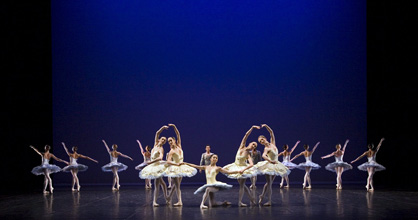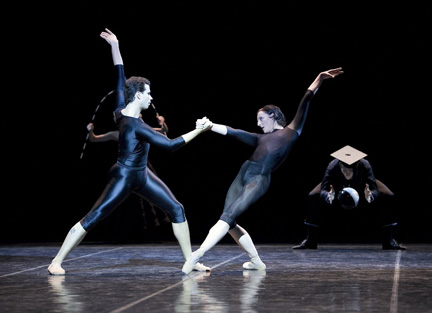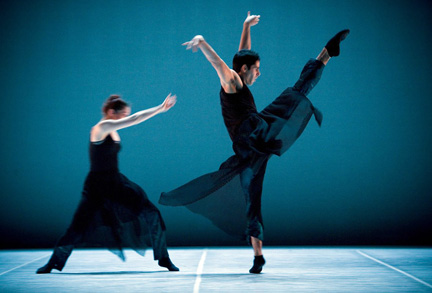Balanchine-Forsythe-Shimazaki
Royal Ballet of Flanders
Theater Het Eilandje
Antwerp, Belgium
18 January 2007
by Marc Haegeman
copyright 2007, Marc Haegeman
 The Royal Ballet of Flanders’ first programme of the year brought a noteworthy triple bill, combining George Balanchine’s Divertimento No. 15 with William Forsythe’s New Sleep and a world-premiere, Eyes in the Sky by Toru Shimazaki. With this varied offering, artistic director Kathryn Bennetts proposed a generous and challenging evening, set above all to demonstrate the versatility of the company. All three pieces were new to the company.
The Royal Ballet of Flanders’ first programme of the year brought a noteworthy triple bill, combining George Balanchine’s Divertimento No. 15 with William Forsythe’s New Sleep and a world-premiere, Eyes in the Sky by Toru Shimazaki. With this varied offering, artistic director Kathryn Bennetts proposed a generous and challenging evening, set above all to demonstrate the versatility of the company. All three pieces were new to the company.
Balanchine has never been a speciality of the Royal Ballet of Flanders. The few Balanchine ballets the company acquired over the years were in most cases dropped after one or two seasons. Last year’s Theme and Variations was an admirable effort, but ultimately failed to make its point because it takes more than a handful of performances to master a Balanchine ballet of this scale and complexity. A reprise in this season might have been preferable for the dancers instead of trying out a new ballet already, the magnificent but equally multifaceted and hyper-delicate Divertimento no. 15. Opening this triple bill it left, not surprisingly, a feeling of incompleteness for much the same reason.
Mozart Divertimento no. 15 was rehearsed by Victoria Simon and and the costumes were designed by Holly Hynes. In the second-cast performance I attended, the five ballerina roles were danced by soloists and artists of the corps de ballet, and they weren’t matched. (I understand the premiere cast gathered several of the company’s principals and first soloists.) The variations were done with the usual enthusiasm, however with the exception of Yurie Matsuura and Karina Jäger-von Stülpnagel, they remained faceless exercises. The duets in the andante were generally well danced but lacked the required continuity. Corps de ballet artist Matsuura danced in any case a remarkable evening, easily outshining her fellow dancers. Among the three cavaliers it was Mikel Jauregui who stood out by his clarity and attack.
Overall, the ballet might have benefited from a less leisurely pace. It undoubtedly allowed the dancers to tackle the choreography with more ease, but as yet their approach (at least judging from this second cast) seemed too indifferent and no clear idea of classicism took shape. Again, a commendable attempt, considering the ballet was brand new, but nonetheless a Balanchine which as yet leaves far too much ground uncovered. And that’s a shame because, eventually, neither the public nor the critics warmed to it.
It’s essential to have live music, yet the members of the Beethoven Academie conducted by Koen Kessels occasionally lacked focus and sounded rather heavy-handed. (Incidentally, this was one of the orchestra’s last public appearances, since lack of funding forces the 14-year old ensemble to cease its activities this year.)
 In harsh contrast with the luminosity, poise and delicacy of Balanchine’s 50-year-old masterpiece followed Forsythe’s cartoony aggressive world of darkness, clatter and distortion. New Sleep, set to a soundtrack by Thom Willems, was created for the San Francisco Ballet in 1987 but hadn’t been performed since the early 1990’s. Kathryn Bennetts, who was for fifteen years Forsythe’s close collaborator, acquired it for Flanders. Even though New Sleep has now long lost its originality and boldness, it needs to be said that the company proved very much at home in it. Especially Geneviève Van Quaquebeke and Howard Quintero as the leading couple showed remarkable assurance in the customary outsized shapes and pumped-up energy. Nothing but praise as well, for the technical crew keeping everything together. The Royal Ballet of Flanders still needs to find its way with Balanchine, but this early Forsythe comes well within reach.
In harsh contrast with the luminosity, poise and delicacy of Balanchine’s 50-year-old masterpiece followed Forsythe’s cartoony aggressive world of darkness, clatter and distortion. New Sleep, set to a soundtrack by Thom Willems, was created for the San Francisco Ballet in 1987 but hadn’t been performed since the early 1990’s. Kathryn Bennetts, who was for fifteen years Forsythe’s close collaborator, acquired it for Flanders. Even though New Sleep has now long lost its originality and boldness, it needs to be said that the company proved very much at home in it. Especially Geneviève Van Quaquebeke and Howard Quintero as the leading couple showed remarkable assurance in the customary outsized shapes and pumped-up energy. Nothing but praise as well, for the technical crew keeping everything together. The Royal Ballet of Flanders still needs to find its way with Balanchine, but this early Forsythe comes well within reach.
The final offering, Toru Shimazaki’s Eyes in the Sky, wasn’t in any way in the same league and would have been better served as an opener — or in a programme with less prestigious company. Japanese Toru Shimazaki was trained at the Goh Ballet Academy and danced with the Goh Ballet Company in Vancouver, before choreographing for companies in Europe and in Japan. Last year he made a piece for the Royal Ballet School in Antwerp and was subsequently invited to create for the company.
 “The choreography is without narrative” explains the program book, “but not without theme: everyone, no matter what he or she does, is followed from above, whatever his beliefs or convictions. That is why we so often raise our eyes to heaven when despair or wonder strike us.” Quite so. A group of ten female and eight male dancers, clad in disagreeable unisex frocks, moved about on a bare stage in dreary activity. Duets resembled variations of how to curl a woman around you while the ensemble work was oddly short on inspiration. It had a recorded minimalist score by Frenchman René Aubry, reportedly confected from several compositions of his from the 1990’s, rattling in the back without further consequence. Unlike the preceding works, this is the sort of dance exercise that explores little or nothing, challenges nobody except the audience’s patience, doesn’t go anywhere, but dies quite soon on the stage stuck in its own repetitive, tensionless pattern. The presence of some of the company’s most gifted dancers, like Aki Saito, Wim Vanlessen and Alain Honorez, seemed a waste since Shimazaki overlooked their personalities and individual qualities.
“The choreography is without narrative” explains the program book, “but not without theme: everyone, no matter what he or she does, is followed from above, whatever his beliefs or convictions. That is why we so often raise our eyes to heaven when despair or wonder strike us.” Quite so. A group of ten female and eight male dancers, clad in disagreeable unisex frocks, moved about on a bare stage in dreary activity. Duets resembled variations of how to curl a woman around you while the ensemble work was oddly short on inspiration. It had a recorded minimalist score by Frenchman René Aubry, reportedly confected from several compositions of his from the 1990’s, rattling in the back without further consequence. Unlike the preceding works, this is the sort of dance exercise that explores little or nothing, challenges nobody except the audience’s patience, doesn’t go anywhere, but dies quite soon on the stage stuck in its own repetitive, tensionless pattern. The presence of some of the company’s most gifted dancers, like Aki Saito, Wim Vanlessen and Alain Honorez, seemed a waste since Shimazaki overlooked their personalities and individual qualities.
All photos by Johan Persson, from top:
"Divertimento No. 15," the company.
"New Sleep," Howard Quintero and Geneviève Van Quaquebeke.
"Eyes in The Sky," Eva Dewaele and Ernesto Boada
Volume 5, No. 5
January 29, 2007
copyright ©2007 Marc Haegeman
www.danceviewtimes.com